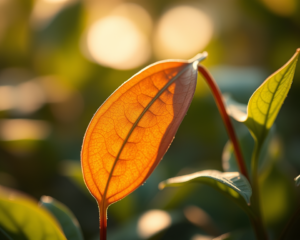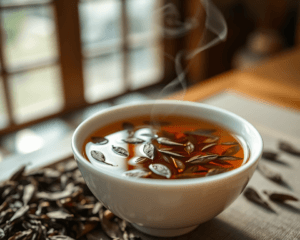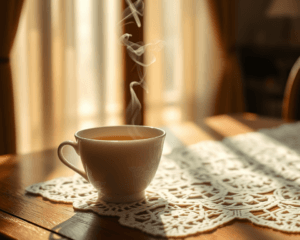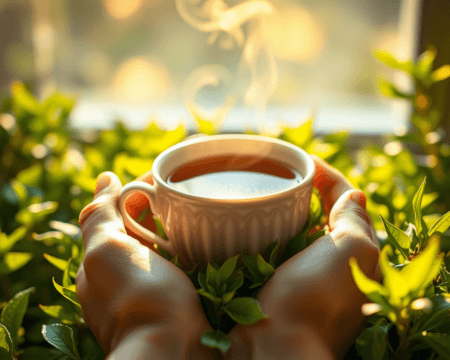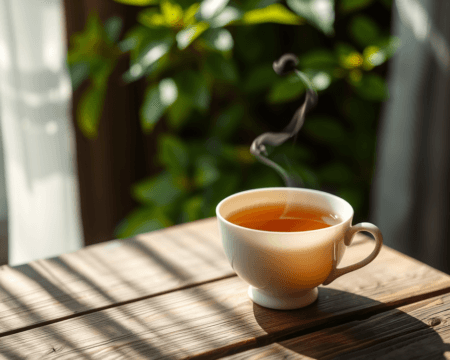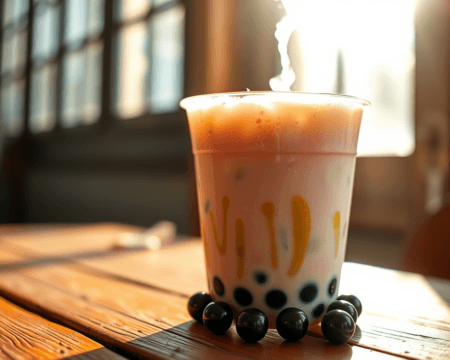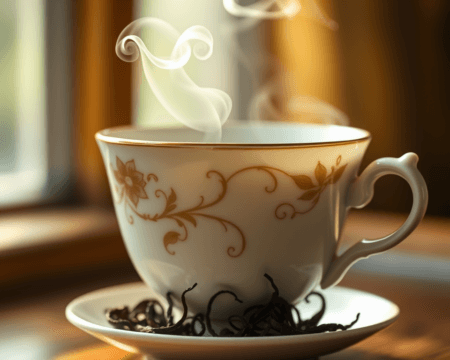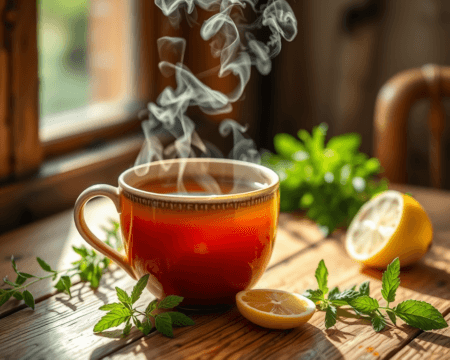Tea—it’s more than just a drink; it’s a cornerstone of culture, tradition, and history. The steaming cup that warms your hands has a legacy that stretches back thousands of years. What if I told you that every time you sip your favorite brew, you’re participating in an ancient ritual? No doubt, tea has played a pivotal role in societies all around the globe, and there’s a treasure trove of fascinating stories behind its origins. So, fasten your seatbelt as we journey through time, unearthing the mystical realms of tea’s history and its significant players.
Key Takeaways
- The legend of tea’s discovery revolves around the mythical emperor Shen Nong.
- Archeological evidence showcases tea’s use in ancient and prehistoric cultures.
- Key figures like Buddhist monks helped disseminate tea culture, influencing rituals and consumption patterns.
- Cultural significance spans from Chinese society rituals to global variations like British afternoon tea and Indian chai.
- Numerous myths exist about tea’s origins, with interesting facts often contradicting popular beliefs.
The Historical Context of Tea’s Invention
The Legend of Tea’s Discovery
Imagine this: ancient China, around 2737 BC. Emperor Shen Nong, known as the father of herbal medicine, is boiling some water. As fate would have it, leaves from a nearby Camellia sinensis tree flutter into his pot. Shen Nong takes a taste and boom! The discovery of tea happens. This story is one of many tea discovery myths shrouded in Chinese folklore. It’s a beautiful anecdote that captures the romance behind tea’s origins, cementing its status not just as a drink but as a symbol of healing and spirituality.
While the legend paints a captivating picture, we know there’s more to the story. After all, the hobby of sipping comforting brews didn’t just appear out of thin air. The depths of tea mythology and ancient practices provide insight not only into the beverage but also into the way ancient cultures interacted with the world around them.
Archeological Evidence and Ancient Cultures
Fast forward a few centuries, and we find ourselves sifting through archeological findings that tell a different tale. Evidence of early tea consumption dates back to the Han Dynasty (206 BC – 220 AD). Researchers found remnants of tea leaves alongside items like pottery and cooking utensils in ancient graves, supporting the idea that this herbal infusion was a vital part of daily life. Those early historical artifacts reveal an intricate relationship between tea and culture, indicating it wasn’t just a beverage but a conduit for social interactions within ancient civilizations.
The emergence of traditional tea culture across different Chinese dynasties speaks volumes about its integration into everyday practices. Whether for medicinal purposes, ceremonies, or simply for enjoyment, tea was more than a drink; it was a cultural touchstone.
Key Figures in Tea’s History
Shen Nong: The Father of Tea
Shen Nong isn’t just a legendary figure; he’s at the core of tea lore. His life is dotted with remarkable tales of innovative farming and herbal medicine, making him a pivotal character in the saga of tea. Known for his meticulous nature, Shen Nong tested hundreds of herbs for their medicinal properties. Imagine being the scientist of ancient China, all while sipping on nature’s finest brews!
His contributions shaped the culture of tea as we know it today, establishing it as a serious contender for everything from a comforting beverage to a spiritual companion. With a biography that could fill volumes, Shen Nong’s days of trial and error led to an explosion of interest in ancient remedies involving tea, influencing generations.
The Influence of Buddhist Monks
If you think tea’s just about sipping and savoring, think again. By the time the Buddhist monks entered the scene, tea became a conduit for spiritual practices. These monks took the concept of tea far beyond mere enjoyment. They blended tea rituals with meditation, creating a unique cultural exchange that spread like wildfire across Asia.
Zen Buddhism embraced tea as a vehicle for mindfulness, turning the simple act of brewing into a meditative art form. You could sit with a cup of matcha in a tranquil garden, and suddenly you’re transformed. The blend of tea practices along with the spiritual teachings of Buddhism created an intertwining of cultural legacies that thrive even today.
The Cultural Significance of Tea
Tea in Chinese Society
In Chinese society, tea isn’t just a drink—it’s a way of life. Picture buzzing tea houses filled with laughter, offers of freshly brewed green tea, and the clinking of porcelain cups. Chinese tea culture embodies a plethora of cultural rituals rooted in history and tradition. The act of pouring tea isn’t just about refreshment; it embodies kindness and respect.
From formal ceremonies to casual gatherings, tea plays a central role in the social fabric. The etiquette surrounding tea gatherings reflects deep cultural values, showcasing how something as simple as tea can elevate relationships and foster connections. Don’t underestimate its impact; tea is a conversation starter and often the centerpiece of celebrations.
Global Spread and Regional Variations
Leave China, and you’ll find tea has spun its tale worldwide—each culture adapting it to their unique flavors and customs. Traveling to England? You’ll likely encounter afternoon tea, which has become a staple of British life. Think scones, finger sandwiches, and a proper cup of Earl Grey. In contrast, head to India, and your experience will be a colorful explosion of flavors with masala chai, featuring a melange of spices and milk.
We can’t forget Japan and its iconic matcha ceremonies—an intricate dance of preparation that transforms tea into an art form. And let’s talk about the cultural fusion created by tea globalization, where influences meld together, generating innovative brews. The journey of tea from its cradle in ancient China to the tables of every continent illustrates the beverage’s dynamic nature.
Myths vs. Facts About Tea’s Origins
Common Misconceptions
But here’s where it gets interesting. With all that history, it’s no surprise that tea myths abound. Many folks believe that tea was discovered purely for its taste, while others have drawn elaborate stories around its origins. Remember that myth about tea being discovered accidentally by a clumsy emperor? Sure, it’s a fun tale, but the truth is often lost in the mix of folklore analysis and popular beliefs. If you peel back the layers of history, you might uncover a reality that’s quite different from the romanticized stories we tell.
The Truth Based on Historical Evidence
Let’s clear the air with some verified history. Various historical documentation indicates that evidence of tea-like beverages predates Shen Nong. Research studies show that ancient communities were brewing herbal infusions long before it became globally popular. Tea’s evolution is filled with twists and turns, making it a captivating narrative of cultural blending and adaptation.
The tea timeline offers insights into how different cultures embraced the drink and how it transformed over time, becoming an integral part of daily life, rituals, and even trade. Each leap forward in the tea saga reveals a deeper understanding of human connection and experience.
The Evolution of Tea Preparation Methods
From Ancient Brews to Modern Techniques
To truly appreciate tea, one must witness its journey from traditional brewing methods to today’s innovations. Ancient brews involved simple steeping techniques, relying heavily on the environment and local ingredients. Fast forward to modern-day practices, where you can make tea using gadgets that wouldn’t be out of place in a sci-fi movie. Yet, the essence remains unchanged—the connection, the aroma, the flavor.
Explore how the preparation has evolved through different cultures. You’ve got everything from Hong Kong’s milk tea to the Chinese ceremony of Gongfu Cha. It reflects the beautiful intertwining of tradition and modernity, showing that while technology advances, the heart of tea remains steadfast.
Cultural Influences on Tea Preparation
Tea preparation isn’t just a series of steps; it’s a cultural expression. Each region boasts unique brewing methods that reflect local customs, flavors, and rituals. For instance, Japanese matcha preparation is a meticulous art that emphasizes precision and mindfulness. It’s not merely about making tea; it’s about creating an experience.
Local customs and the influence of rituals have transformed how tea is made and enjoyed, leading to diverse tea preparation techniques across the globe. Whether you’re brewing with a traditional clay teapot or using a modern tea infuser, each cup tells a unique story—a tale of history, culture, and community.
So, the next time you clutch your favorite mug, remember that you hold centuries of stories, wisdom, and global influences. Tea isn’t just a drink; it’s a journey through time. Cheers to that!
Frequently Asked Questions
Who is Shen Nong in the context of tea?
Shen Nong is a legendary figure in Chinese history, often regarded as the mythical emperor who discovered tea. According to folklore, he is said to have stumbled upon tea while boiling water, and the leaves accidentally fell in, leading to the first brew.
What evidence exists about tea’s ancient use?
Archaeological findings, such as tea leaves in tombs and pottery, indicate that tea was consumed in various ancient and prehistoric cultures, particularly in China. These discoveries highlight tea’s historical significance and suggest it has been valued for thousands of years.
How did Buddhism influence tea culture?
Buddhist monks played a pivotal role in promoting tea as a beverage and ritualistic drink. They integrated tea into their practices to enhance meditation and alertness, which then permeated various aspects of Chinese culture and beyond, leading to its global dissemination.
What are some cultural differences in tea drinking?
Tea drinking varies significantly worldwide. In Britain, afternoon tea is a cherished social event, while in India, chai—a spiced milk tea—holds cultural importance. Each culture has its own rituals, preparation methods, and significance surrounding tea consumption.
Are there any notable myths about tea’s origins?
Yes, several myths exist surrounding tea’s origins, including stories of its mystical healing properties and divine associations. These narratives often differ from documented history, creating a rich tapestry of lore that enhances tea’s intriguing background.
What types of tea are most commonly consumed around the world?
There are many types of tea enjoyed globally, including green, black, oolong, white, and herbal. Each type varies in flavor, preparation, and health benefits, catering to diverse preferences and cultural practices.
How has tea culture evolved over time?
Tea culture has evolved significantly from its ancient roots, influenced by trade routes, colonization, and globalization. This evolution has led to varying practices, tea types, and associated rituals that reflect the unique tastes and traditions of different regions.
Can tea have health benefits?
Yes, tea is known for various health benefits. Many types of tea are rich in antioxidants and may promote heart health, improve digestion, and enhance mental clarity. However, the effects can vary depending on the type and preparation of the tea.
What is the traditional way of preparing tea in China?
In traditional Chinese tea culture, tea preparation often involves a process called Gongfu Cha. This method emphasizes using smaller teapots, precise water temperatures, and multiple infusions to extract the full flavor profile of the tea leaves.
Is it true that tea can be caffeinated or caffeine-free?
Yes, tea can contain varying levels of caffeine depending on the type. Black and green teas typically have caffeine, while herbal teas are usually caffeine-free. It’s essential to check the specific variety you’re consuming for clarity on its caffeine content.
